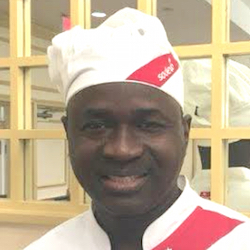
One of the joys of being a chef at a senior living community is the opportunity to reinvent. It’s exciting to refine your dishes and dining service to keep up with evolving tastes, trends and nutritional needs. This can be a challenge, but it’s also a chance for culinary team members to draw on their experience, tap their creative energy and forge bonds with residents.
In my two decades cooking for senior communities, I’ve been fortunate to be part of transformative changes in the industry. Along the way, fads and trends have come and gone. The lasting trends result in flavorful, nourishing menu items and a timeless dining experience that makes the difference in the daily lives of residents.
Here are three successful dining trends in senior living:
1. Freshness comes first
Fortunately, we’ve returned the focus to freshness and flavor. That includes cooking more à la carte items with small-batch side dishes while using herbs and spices instead of high-sodium sauces.
Back in the 1990s, the techniques and skills I’d honed in the restaurant industry – searing, braising, blanching, seasoning – all seemed abandoned in favor of convenience and expediency. Many meals were prepared well in advance, then steamed to excess and heavily sauced.
Now, we use locally sourced sustainable ingredients, which are highlighted on the menu so residents know their food is coming from nearby farms. Like many communities, we’re also considering starting our own community garden and working to establish an onsite bakery to expand the availability of fresh and gluten-free baked goods and desserts.
2. Variety adds value
We offer far more variety today with an extensive array of main courses, including farm-to-table options and global cuisine.
Today’s menus are far more appetizing than those of years ago when the standard senior living menu consisted of chicken, fish (almost always haddock or whitefish), or beef (usually ground beef or chopped steak), the choice of two vegetables, and mashed potatoes or rice. Our menus today have featured spinach cassoulet with braised pork belly, lemon-crusted Arctic char, and cabernet-braised boneless veal shank with Israeli couscous. Gluten-free and vegetarian items, as well as at least ten different options for vegetables and starches, are available daily.
We introduce new dishes with attention and care. New items are always advertised a day ahead in order to answer residents’ questions and satisfy any health or dietary concerns. We discuss unusual international plates before rolling them out. At Asbury Methodist Village, I’ve had great success with a Moroccan Chicken dish after taking the time to personally explain in detail how it is prepared with yogurt, spices, and dried fruit. Since then, it’s become one of our most in-demand items.
3. Bring the kitchen into the dining room
Engaging residents, garnering feedback, and incorporating those suggestions into your menu is just as important as proper execution in the kitchen. It goes beyond simply collecting comment cards. I regularly dine with residents at a “Chef’s Table” to create an open dialogue about what our culinary team is trying to accomplish, get their opinions, and foster relationships. Doing so not only builds mutual trust and understanding, it gives residents a say in their dining experience.
Incorporating “Action Stations” where residents can order food on-demand and watch it be prepared on the spot is a big hit. Typically, communities only offer these as make-your-own omelet or waffle stations during brunch. However, we’ve expanded such presentations to dinner, including a gluten-free pasta bar with various sauces, a southwestern taco station and comfort fare like liver and onions. These popular, informal cooking demonstrations deliver good food fast – they offer all the sights, sounds, and smells of a home-cooked meal.
As a chef, I’ve always felt you can do so much to ensure your guests have a memorable dining experience. That was one of the reasons why I chose this profession, and in the senior living industry.
The shift in residents’ expectations is that they want to know the source of the ingredients used to prepare their meals. They want to experience the culinary process firsthand. The role of a chef in a senior living community remains vital and goes beyond the kitchen. Cooking is a passion and an art. It’s also a family-oriented experience. Just as we craft each dish as if for our own parents or grandparents, we must embrace opportunities to gather and enjoy mealtime as a community.
As senior dining continues to trend toward cultural diversity, sustainability, and accessibility, the ultimate measure of our success will be determined by our ability to keep innovating, keep listening, and keep adapting to exceed the expectations of our residents.
Basiru Jeng is the Sodexo Executive Chef at Asbury Methodist Village.
McKnight’s Senior Living welcomes marketplace columns on subjects of value to the industry. Please see our submission guidelines for more information.


